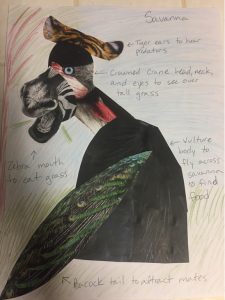Unpacking Habitats

To view the photo-rich magazine version, click here.
Originally appears in the Summer 2019 issue.
CONSERVATION EDUCATION offers an opportunity for us educators to inspire students to think about the planet we live on and how humans impact it. We have the opportunity to mold the minds of the present and future, to become stewards for our planet, and to be mindful of our choices. Our Earth’s habitats are both connected and unique, each requiring specific adaptations from their attendant plant and animal species for their survival. This five-day second-grade unit educates students on eight habitats1 — savanna, prairie, rainforest, coniferous forest, deciduous forest, desert, tundra, and ocean — and the adaptations necessary for plant and animal species to survive in each. Furthermore, it teaches students about the ways in which humans interfere with the usefulness of a species’ adaptations in their natural environment. When humans build on untouched lands, the species that live there either have to adapt or move; if they don’t, species often die because their adaptations are no longer suited for the environment in which they live. Educating children on human impacts allows them to be thoughtful of their actions and ultimately produces adults who have empathy regarding nature and conservation (Chawla, 2009; Ewert, Place, & Sibthorp, 2005; Krasny & Tidball, 2012; Wells & Lekies, 2006).
Throughout this unit, second-grade students discuss the eight habitats, and species’ adaptations to those habitats, by pulling from personal experiences as well as online and print media. They engage in creative activities that produce artwork demonstrating what they’ve learned from the lessons. They also take part in a conservation opportunity within their community. To finalize the unit, students pledge to adopt a new behavior that promotes conservation in a habitat of their choice, as a way to reduce their negative environmental impact on Earth. To aid students in their learning prior to or throughout this unit, it is helpful to check out books from the school library for students to read or have them complete online research about the eight habitats, adaptations, and how humans impact other species. These materials will provide students with guidance in their learning and a starting point for discussions.
This content is restricted to subscribers only.
If you are not yet a subscriber, please consider taking out a subscription here.
If you are an existing subscriber, kindly log in or contact us at info@greenteacher.com for more information.










